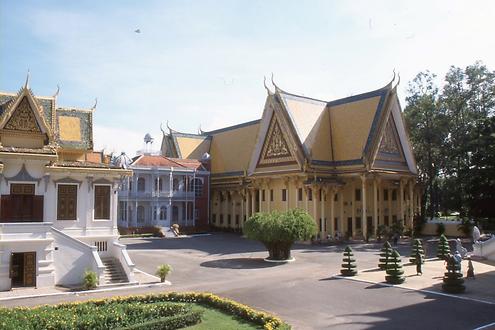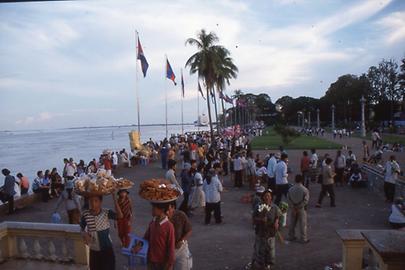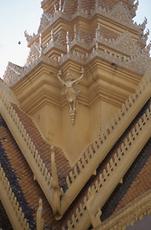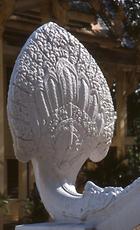The King's Palace in Cambodia's capital: Used by kings and communists#
byAll pictures were taken by the author in 2002 and 2003 and are part of his archive "Pictureflood Jontes".


Cambodia Camboida, Asia is probably one of the most tortured countries in Asia. Historically, Preah Réachéanachuk Kampuchea is based on one of the most splendid kingdoms of Southeast Asia, the Khmer. Their immortal architectural remains culminate in the huge complex Angkor.
Incorporated into the late French colonial empire, Combodia was granted independence in 1953. In the second Indo-Chinese conflict Cambodia was attacked by the Vietcong. As a consequence, the US Air Force made heavy bombardments from 1969 to 1972. The most terrifying period in the history of Cambodia was experienced under the communist reign of terror of the Khmer Rouge. The dictator Pol Pot wanted to create a self-sufficient farmers state designed according to Mao Zedong. He disolved the cities. After the extermination of the intellectual elite the population was deported to the countryside. This experiment killed 3 million people. They died during heavy labor, were tortured to death in prisons or killed in the "Killing Fields". This terrifying regime lasted from 1975 until 1979, when Vienamese troops put an end to the horrific episode and installed a pro-Vietnamese government.
The capital Pnom Penh Kambodscha, Pnom Penh („Hügel Penh“) has today again around 1,5 million inhabitants. After the liberation the deported population returned to the city. Previously, the city was populated by the communist elite. Under the French rule Cambodia remained a kingdom which was reigned from 1941 to 1955 and 1993 to 2004 by one of the most colourful characters of Asia, King Norodom Sihanouk (1922-2012). In 1975 Pol Pot proclaimed the Democratic Cambodia and curiously, placed Sihanouk as head of state. He was removed as head of state because of criticising the communist regime and was put under house arrest for a long time. Then he was granted asylum in China. Under the pro-Vietnamese government, after the displacement of the Red Khmer, he became again king in 1993. In 2004 he resigned in favour of his son.
The royal coat of arms is depicted in many forms on the buildings of the kings's palace in Pnom Penh.
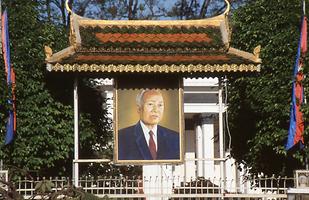
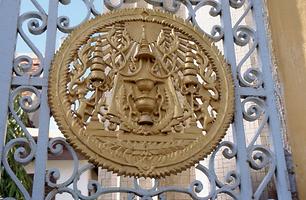
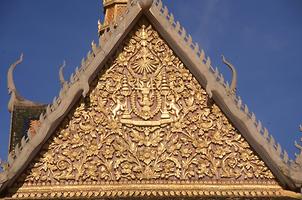
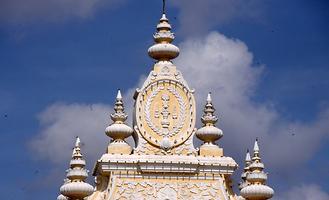


Cambodia’s capital is located on the Tonle Sap („Large lake“). It is a river that is like a lake. During the year it changes the direction of flow depending on the quantity of rain prior to entering the Mekong. As a lake it is the largest in Southeast Asia.
The King’s palace in Pnom Penh was built in the 19th century as a spacious complex of buildings with functional characteristics, gardens and parks. The architecture is influenced by the typical Cambodian Buddhism. Population and royal family are followers of the Theravada-Buddhism, which adhere to the traditions and teachings of the historical Buddha Shakyamuni. Since he ascended from Hinduism as a reformer he did not challenge the Indian gods but he considered them to be rather ineffective on the way of salvation of human beings. Therefore, in the complex of the Kings’s palace, there are also Hindu sites and court brahmans following the cult of Shiva and Rama. Hinduism influenced especially the art of dancing and of visual arts.

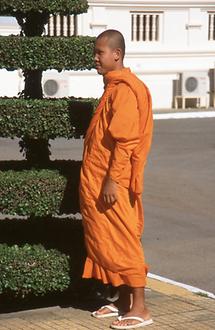
Surrounded by a richly designed wall, the palace complex constitutes a city by itself. Buildings for residential use alternate with religious cult sites. An separate building for the royal library and the dance hall serve for education and edification. Pagodas with its tapering stair-step descending helmets emphasize the complex upwards. Not surprisingly, the heads of the Khmer Rouge lived here the usual luxury life of the communist leaders while the populataion starved and was massacred.




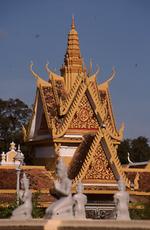
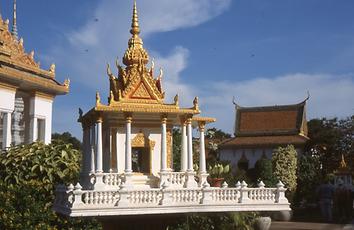

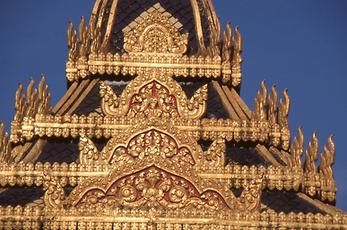
The gentle outlines of the buildings show many detailsof subtile masonry, created either in stucco or in stone.
Although Combodia turned to Buddhism in the Middle Ages, the Hindu epic of Ramayana played a special role in high art, which culminates in the dance theater. A similar development one finds in the adoption of the epic called Ramakien in Thailand. One of the most prominent buildings in the palace constitutes the dance hall on columns where the court listened to the artificial and musically accompanied performances of Ramayana. King Norodom Sihanouk was an enthusiastic supporter of this art. It is due to him that the dance theater became again popular after the cultural devastation of the country by the murderous communism. The king drafted himself choreographies.



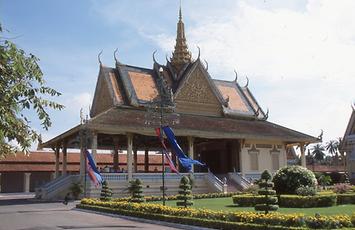

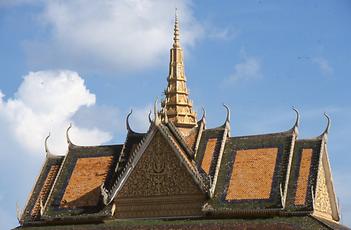
The plot of this old-Indian and next to Mahabharata most important epic is shown on wall paintings in the palace premises. Especially the depictions of numerous battles and duels are very interessting.
This epic got its last version from the poet Valmiki in the 2nd century. Rama is a royal prince. He has two brothers, Lakshmana and Shatrugana who help him. On the king’s court of Videha, Rama wants to marry the king’s daughter. In a competition with further candidates Rama has to use an huge bow. He is the only one to succeed and wins Sita as wife. Rama ought to be heir to the throne at the court of his father. Intrigues prevent him, however. Together with his wife Sita and Lakshmana he is banned into the virgin forest, where they experience numerous adventures with monsters and demons. One of them, Ravana kidnaps Sita by using a trick and takes her to the island Lanka. With the assistance of the monkey god Hanuman, who takes him and his companions through the air to Lanka, he fights with Ravana and defeats him. Sita is freed. However, Rama doubts whether his wife remained loyal to him. Because of this unreasonable demand Sita is disappointed to such an extent that she treis to kill herself by burning in fire. But the gods intervene, Thus, this grand adventure has an happy ending.
As dance drama in an exactly definded choreographic form of expression the Ramayana belongs to the immortal cultural heritage in Southeast Asia. The solemn and the dramatic staging, the lively accompanying music and the splendid costumes and requisites fascinate also visitors from the West.


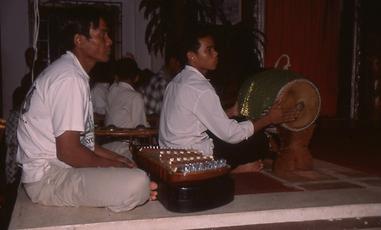

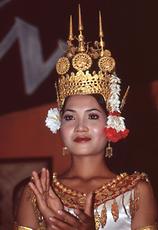

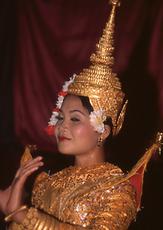
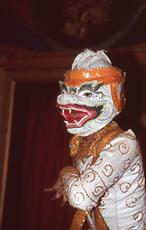





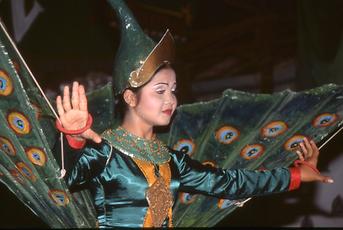
Remarkably squeezed between buildings of local tradition, there is a pavilion that does not really fit into the grown complex of the royal buildings. It is a construction from 1869. On the 12th of November 1869 the opening of the Suez Canal took place. Due to this technical masterpiece the sea route to Asia was shortened in such a way that the world economy made a huge step forward. The whole world was celebrating. Emperors and potentates met at the opening ceremony. Even Emperor Franz Josef of Austria was present and connected this trip with a visit to the Holy Land. Emperor Napoleon III of France, which had enormous colonial positions in Southeast Asia, had a pavilion built in order to be able to live a comfortable life in the desert landscape in Sinai. After the three-day celebration the construction was not returned to France, but disassembled and brought to the King’s palace in Pnom Penh.
